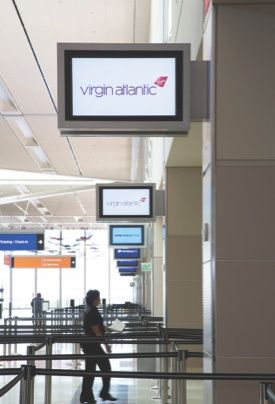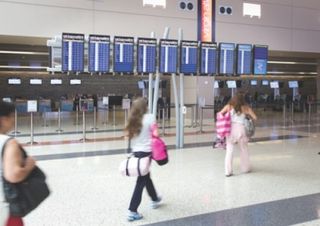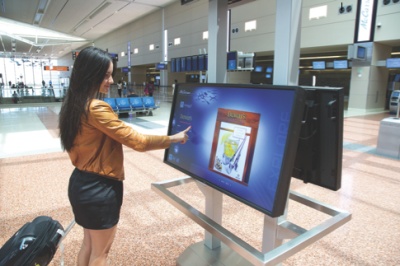McCarran Airport invests in more than 900 displays to launch state-of-the-art terminal
McCarran International Airport in Las Vegas can trace its roots to the 1940s, when it shuttled roughly 1.5 million passengers in and out of Sin City each year. Over the years, the airport has grown along with Las Vegas and the airline industry, building new terminals and conducting renovations to cater to the needs of the more than 41 million travelers that now pass through the airport each year.
In 2007, McCarran embarked upon its most ambitious project to date: the construction of a new 1.9-million-square-foot, $2.4 billion terminal that would host international and domestic flights. After five years of construction, McCarran’s Terminal 3 opened earlier this year. T3 includes 14 gates, seven of which are dedicated to international flights.
“Employing 1,800 people at its peak, the McCarran T3 project positions Las Vegas for the demanding growth in international and domestic travel and our region as the premier tourism destination,” said David Bourgon, manager of airport IT services at McCarran Airport.
Unlike many other destination cities, Las Vegas is a year-round attraction for visitors from all over the world. McCarran welcomes an average of more than 114,000 passengers a day, who bring with them more than 500 tons of cargo.

Digital Signage Lights the Way
With such a large number of travelers filling McCarran Airport each day, getting people to the right place at the right time can be a daunting task. In addition to flight arrival and departure times, the airport needs to provide visitors information on baggage and gates, how to get from one section of the airport to another (wayfinding) and directories with information on local businesses and points of interest.
Bourgon said the best way to streamline this process is with digital signage. The main function for digital signage at McCarran is to provide wayfinding information and gain as much flexibility as possible for IT staff who constantly convey information updates to travelers. The ability to make changes as needed at a moment’s notice is vital to an airport environment, and Bourgon saw digital signage as a strong contender to solve McCarran’s issues.
“Dynamic signage is instrumental in letting passengers know where they need to be and at what time,” Bourgon said. “T3 is home to a number of airlines, but not all airlines use the terminal every day. For example, United Airlines might not have any flights scheduled to arrive in or depart from T3 today, but they will have a number of flights tomorrow. Using digital signage, we can easily change information on the fly to keep our guests informed. With static signage, that becomes a laborious task.”
While digital signage was a key consideration, Bourgon also had to take into account the rigorous demands an airport puts on displays. Just like the casinos the city of Las Vegas is known for, McCarran is operating 24/7.
“It’s not like you can go out and buy consumer TVs to handle the job. Running 24 hours a day, it is very likely that they would reach the end of their useful life within a year. You have to have commercial-grade signage that is durable and can be depended on for the long haul,” Bourgon said.

- A Winning Solution
- Through previous experience with NEC displays that were installed in Terminals 1 and 2 at McCarran, Bourgon knew that NEC products would be up to the task. After discussing the various display sizes needed for T3, he listened to NEC’s recommendations for various units that would best suit the airport’s needs.
- The final deployment called for more than 900 NEC large-screen displays, which included 182 46-inch P461s and 723 40-inch P401s. These models are specifically designed for demanding 24/7 environments like McCarran.
- Digital content management company Four Winds Interactive provided the software for the NEC displays, creating interactive airport directories and dynamic gate information displays on double-sided video walls outside each arrival and departure gate.
- Randall H. Walker, the director of aviation for Clark County who oversees McCarran in his role, said one of their goals with the digital signage was to ensure that modern, helpful amenities were in place for travelers.
- “Four Winds Interactive’s software allows us to do just that by offering a wide variety of useful information via any single interactive sign. This helps patrons better navigate the airport and become aware of factors affecting their travel,” said Walker.
- Using Four Winds’ software, NEC displays at each gate include real-time flight information, weather forecasts and iconic photo backgrounds of travel destinations. To remind travelers of the excitement of Las Vegas, synchronized advertising videos, which include video of falling dice and slot machines in action, are set to play at the top and bottom of the hour on video walls at every gate in T3.
- Wayfinding signs were also enhanced through the use of custom floor maps, providing more than 1,500 path-finding directions that are plotted to help guide visitors to various destinations inside McCarran. “Digital signage is instrumental in guiding our visitors through our new facility and creating lasting positive experiences and memories,” said Bourgon.
- Through the digital wayfinding displays, travelers are able to easily find information about shopping, dining, airport clubs and other airport amenities. A “map it” feature enables travelers to see an animated visual route from their current location to their destination, as well as turn-by-turn directions. The directions can then be easily sent from the interactive display to the travelers’ smartphones using a QR code.
- “Interactive digital signage was essential to this project,” Walker said. “Four Winds’ works were already widely displayed in Las Vegas, and its new contributions will further improve visitors’ and locals’ travel experiences with flying in and out of McCarran.”
- In addition to the more than 900 displays, McCarran also installed more than 800 NEC-SBC-03 single-board computers, which reside in the expansion slot of the P Series displays. Having the ability to place the SBCs in the displays themselves helps to reduce labor costs and improve on the aesthetics of the install.
- Ordinarily, the source computers for flight information displays are mounted high on walls or in the air on pedestals. NEC’s solution eliminates the need for an external PC, cabling, mounting and power supply because RS-232 control, DVI video, stereo audio and power are all passed internally from the display to the device. Typically, the only cable necessary is the power cable.
From a maintenance standpoint, the compact device is entirely removable, which means the entire display no longer needs to be removed. IT administrators can now handle diagnostic tests, install upgrades, and view and control digital display content remotely.
A Simple Choice
McCarran’s T3 opened its doors on June 27, 2012, and while there is not much history to this point, Bourgon said he is very satisfied with the NEC installation.










